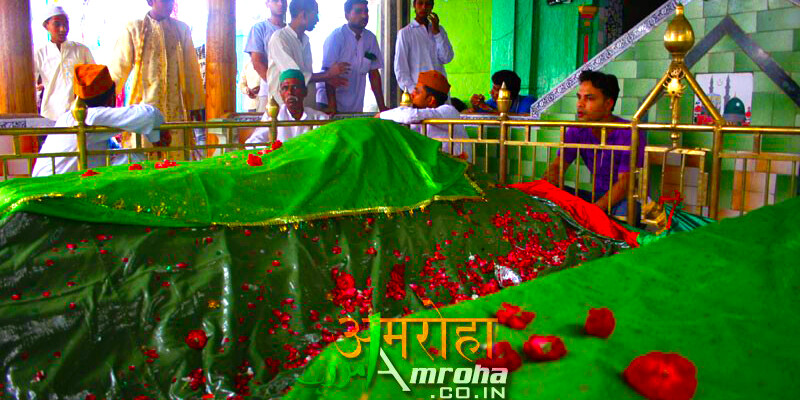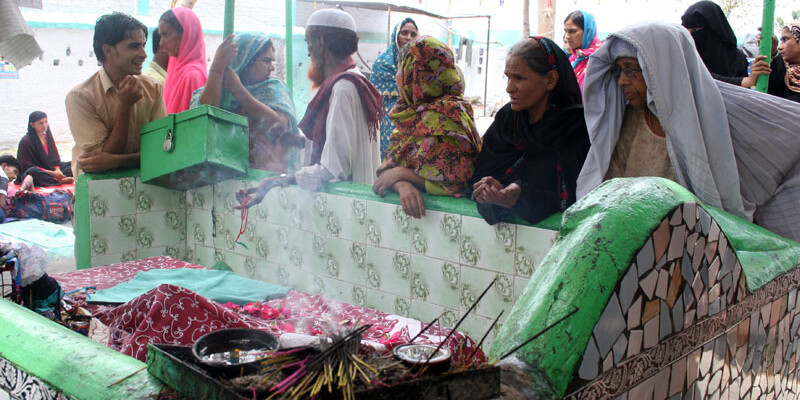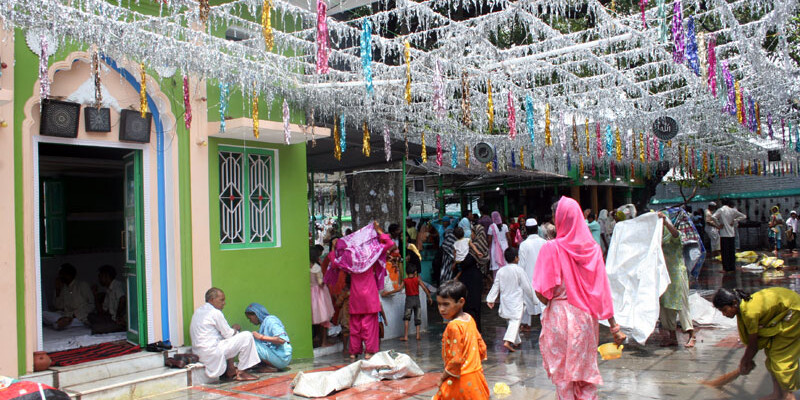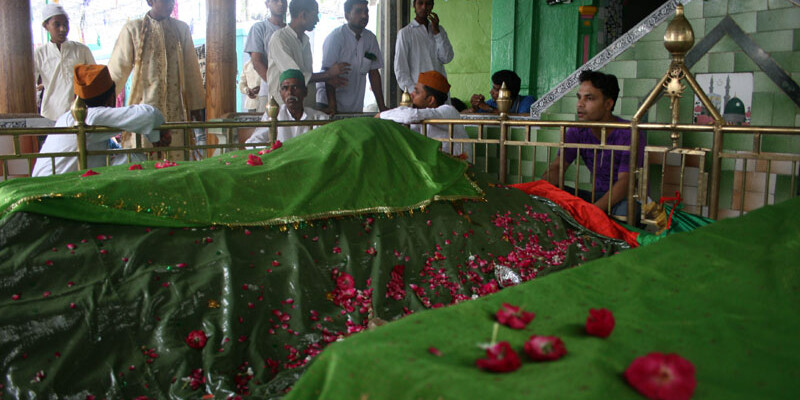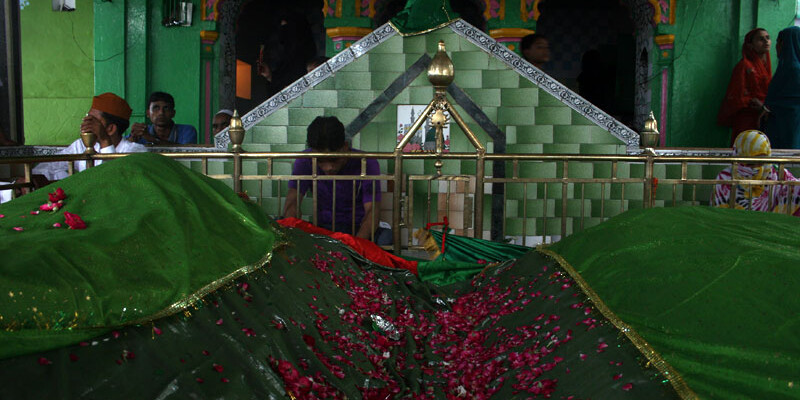Syed Hussain Sharfuddin Shah Wilayat was the son of Mira Ali Buzurg who was a learned scholar. His mother’s name was ‘Umme Habeeba’ and she was the daughter of Syed Abdul Moueed Ali. Syed Jalaluddin Haider Surkh Posh, the famous saint of earlier Muslim Indian Sultanete, was the real brother of Bibi Umme Habiba.
Very few history books are available in India now where Hazrat Hussain Sharfuddin Shah Wilayat is mentioned in any form in relation to larger SUFI Movement of India. Perhaps, his father was shy of éclat and preferred the ascetic life of Amroha which was often referred as Qasba Azizpore in those days. He didn’t make Delhi or any royal city of his final abode. There is no provision of SAJJADA NASHEENI in his hierarchy that is so common and necessary in Sufi Schools. One can safely conclude that he had a limited spiritual domain and he loved the simple life of towns and villages.
The parents of Shahwilayat were direct descendents of Imam Ali al-Naqi al-Hadi (AS) – the 10 th Imam. Imam’s period coincides with the rule of Abbasids – AlWathiq and Al Mutawakkil. These rulers were jealous of Imam’s reverence, popularity an following among ordinary Muslims. He concocted excuses and called Imam from Medina and imprisoned him at Samrrah, Iraq. He achieved martyrdom on 3 rd Rajab 252 AH at the age of 42 years. He left behind five children:
1. Hazrat Imam Hasan (the 11 th Imam)
2. Hazrat Hussain
3. Hazrat Mohammed
4. Hazrat Jafar
5. Bibi Aisha
The ancestors of Shahwilayat migrated to the city of Sauda in Syria and from there to ‘Wasit’ a hamlet in Iraq. This town was established at the bank of River Dajla by Hajjaj Bin Yussuf in 83 AH. After a lapse of considerable time new designs of agriculture and water resources diverted water to other canals and waterways and it resulted in scarcity of water in the town. Political and Administrative frictions compounded and made life unbearable for the descending generations of Syeds of Abbasid Kingdom. Syed Mira Ali Buzurg had three children and one daughter.
1. Syed Hasan
2. Syed Hussain Shahwilayat
3. Syed Mohammed
4. Bibi Umme Salema
Bibi Umme Salema and Syed Hasan died in childhood. In 662 AH, to avoid the persecution and tyranny of ruler they decided to leave their ancestral lands for the good and migrated to Bhakkar in Multan (now in Pakistan).
And according to many scholars, in the year of 670 AH, 2 nd Zil Hij (corresponding to Wed 29 th June 1272 AD) Hazrat Sharafuddin Shahwilayat, his father Syed Mira Ali Buzurg and his family along with many other members of his family group came to India via Multan and settled in Amroha. It was during the rule of Sultan Ghyasuddin Balban. However, some scholars disagree and claim that in 690 AH, during the rule of Sultan Jalaluddin Firoz Shah Khilji, the family landed in Amroha.
Boy Sharfuddin received his primary education Dars-e-Quarn and Hadith at home and his father was his mentor and tutor. As grown-up he was trained in spiritual disciplines by Syed Jalauddin, Syed Bahuddin – the father-in-law of Syed Jalauddin and Moulana Nasehuddin Suharwardi s/o Qazi Hameeduddin Nagori. The names of Saint Arif Suharwardi and Syed Usman Lal Shahbaz Qalander aka Jhulewala are included in the list of his teachers.
He was assigned the area between River Ganges and Kumayun Hills as his preaching spiritual domain by his spiritual guides. He followed the simple ascetic life and his message was universal love and respect. He was admired and received warmly by the people of all the faiths. The fame of his piety and erudition spread in all the four corners around Amroha.
The famous book of Amrohvi history ‘Tareekh-e-Wastiya’ describes Mohalla PACHDARA as the maiden nest for newly arrived family. He was married to Bibi Kaneez Fatima, the daughter of Syed Jalaluddin Bukhari and they had three children.
1. Syed Mir Ali Buzurg
2. Syed Abdul Aziz
3. Bibi Baqia-ut-tahirah aka Bibi Bakhuhi.
Bibi Bakhuhi was known for her piety,simplicity and devotion to prayers. The grave of Bibi comes your sight when you enter the gate of dargah.
There is no authentic record how long Hazrat Sharfuddin stayed in Amroha and then left for Kumyun Hills for meditation and prayers. His trip to Hills was meant to acquire knowledge and practice Riyazat, Chillakashi and special prayers. It was a sort of specialized spiritual training in splendid isolation. For this reason alone he was also called as PEER PAHARI – The Saint of Hills.
Some chronicles have mentioned about the trees he planted in the hills to support his place of meditation which was similar to MACHAN. He brought back those plants to Amroha when he returned. One of those plants survived and is still believed to be sheltering the shrine. He died on 21 Rajab 739 AH and was buried in Amroha.
He had also performed Haj and stayed in Mecca for 7 years. No dated of departure or arrival for Haj are available.
Syed Mohammed Abdal Dooda Dhari, a close relative of Shahwilayat was one of his appointed subordinate but Syed Sharafuddin instructed to discontinue the practice of baiyat and the system of succession was discarded forever in his lineage. Dooda Dhari Saheb died in 798 AH and all the sacred belongings of Hazrat Sharfuddin were buried with him.

